Native Son: AGGIELAND TURNAROUND
So I left work and headed down Highway 6 to see the new teaching garden at the mothership, Texas A&M University. Did I say new? This thing is so new it hasn’t scratched yet.
TAMU has long been known for its Horticulture programs, and now has a place that brings all that textbook talk to life. The seven-acre Leach Teaching Gardens are actually Phase One of a much larger plan simply known as The Gardens at Texas A&M University. Phase One actually has 21 separate components to it, which are woven together so skillfully that I reckon most people would only recognize about a dozen distinct elements.
I arrived at the gardens pre-dawn and had the place all to myself for a good while before people started arriving to tidy up after the VIP Preview the evening before and complete the final touches for the formal dedication at 9:30am. I could blather on endlessly here about what it looks like, but since that old saying about a picture being worth a thousand words is true, let’s get right to it.
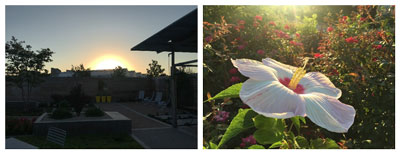
Dawn breaks over a new era for Aggie horticulture, illuminating beauty and enlightening minds. Click image for larger view.
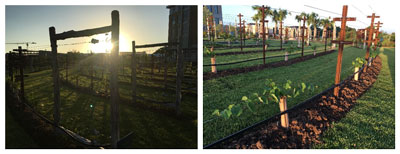
These photos of the vineyard were taken mere seconds apart. Soon enough, lush foliage will cover the trellises. I think this area may create a new TAMU tradition; as the grapes will be ripe in August, I imagine Aggie horticulture students ceremonially plucking a grape as they return to school. Click image for larger view.
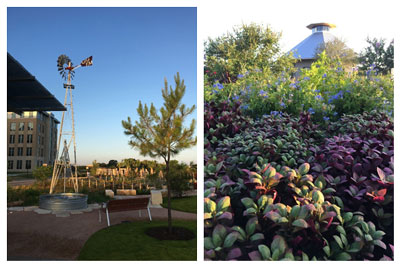
A whimsical windmill welcomes visitors to the garden. Lush beds of Alternanthera and Blue Plumbago surround the Pavilion. Click image for larger view.
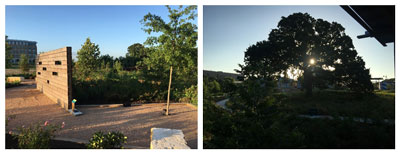
The bird blind wall lets people visitors sneak a better peek at the bird visitors. Morning sun does its own peeking through a massive Post Oak that anchors the southeast corner of the garden. Click image for larger view.
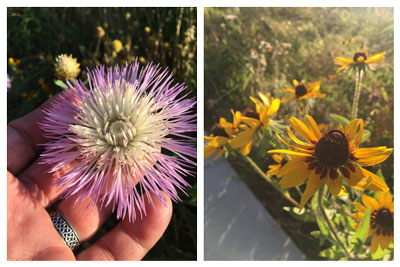
Basketflower (my personal favorite) and Rudbeckia grow feely throughout the wildflower meadows meandering through and past the bird garden down to the creek.
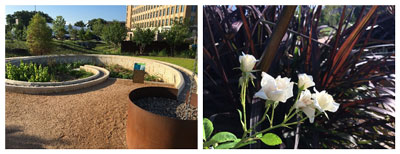
The rain garden focuses on the ecological importance of water. Roses and Pennisetum are perfect partners in the Maroon & White Garden. Click image for larger view.
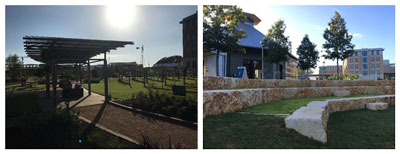
Powerful architectural lines will soon be softened by plant growth, people, and time. The limestone terrace is an irresistible spot to sit and gaze over the wildflower meadow. Click image for larger view.
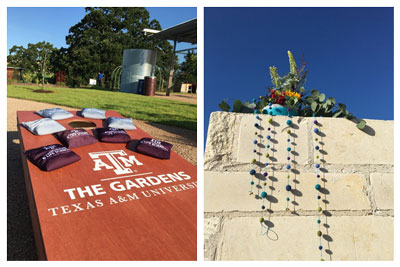
Dedication Day finishing touches included a few cornhole boards and whimsical floral arrangements (literally hundreds of them!) throughout the gardens.
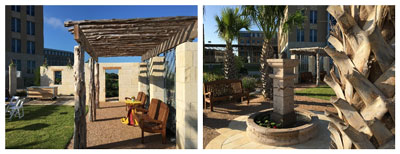
Personally, my favorite area was the Mexican Heritage Garden, where rough-hewn juniper is tamed by sleek architectural lines and the 3D cross-hatching on palm trunks competes with sculpture. Click image for larger view.
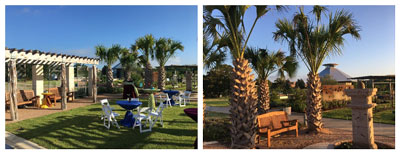
Courtyards and comfort are the hallmarks of Mexican jardíns, and this little jewel captures the spirit well. The contoured wooden benches here are easily the most comfortable seating around the seven acres. Click image for larger view.

Left: Old friends getting older. At left is Garden Manager Joseph Johnson, wearing a two-tone smile of pride and relief that Phase One is now complete. In the center, celebrated Horticulturist Greg Grant leans away from me (right) after my joke about the side effects of beans. Right: After the official dedication brouhaha, I met Greg at the Dixie Chicken for lunch. I was stunned to find out he had never been there before. There’s always something new to discover in Texas…even something old! Click image for larger view.
I didn’t attend the official dedication ceremony. After more than three hours exploring the garden, I didn’t want formalities to knock the buzz off my emotional connection to the site. As I was walking out, I envisioned the garden a few years from now; matured, seasoned, the shiny patinas turned mellow—a garden as it should be. Threading my way upstream through the hundreds of people coming in for the ceremony, I noticed a swagger on many students. That stride of pride and new-found confidence that comes with being a part of something so much larger than yourself. And I thought about how different those students will be just a few years from now; matured, seasoned, the newness worn off…just like graduates should be. And just like the garden…where they will learn many of the life lessons they will carry with them forever.
Admission is free to The Gardens of Texas A&M, which are open dawn to dusk. Paid public parking is available at several locations (You can call 979-862-7275 for assistance or go to gardens.tamu.edu for details). A word of caution to visitors—do NOT just pull up nearby and park, even if there is an empty parking lot the size of New Hampshire just sitting there. You will very likely get ticketed or towed if you don’t have a parking sticker.
The Gardens of Texas A&M are located at 556 John Kimbrough Boulevard, College Station, TX 77843 (at the intersection of John Kimbrough Boulevard and Penberthy Road, across from Reed Arena). The main entrance to the gardens is behind the AgriLife Center.
The Leach Teaching Garden is named in honor of Amy & Tim Leach of Midland, Texas, who contributed the founding gift to the garden.
____________________________
I need a road trip! Let me know if you’d like me to come and speak to your group sometime. I’m low maintenance, flexible, and you know I like to go just about anywhere. No city too big; no town to small. Just send me an e-mail at stevenchamblee@yahoo.com and we’ll work something out.
Come out and see me at Chandor Gardens! Located in the heart of Weatherford’s Historic District, Chandor Gardens is the perfect place to get away and enjoy the simple pleasures of life that can only be found in gardens. Call 817-613-1700 or visit www.chandorgardens.com for details.
